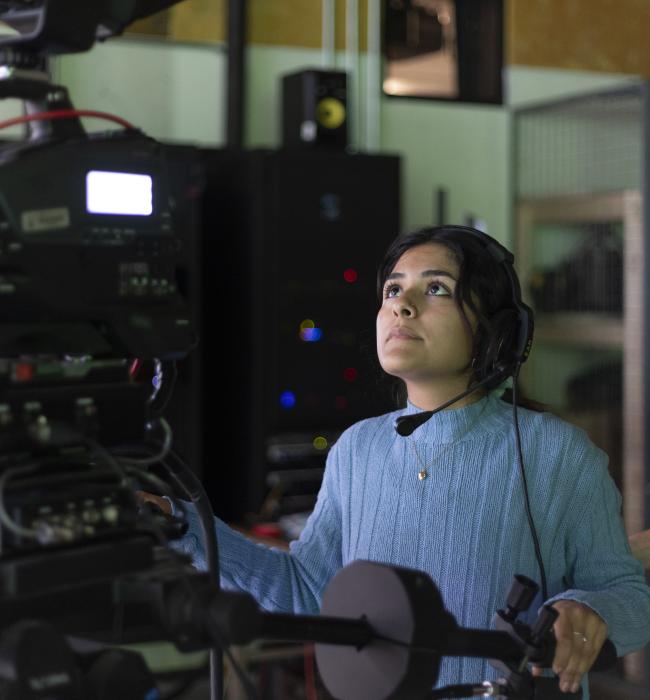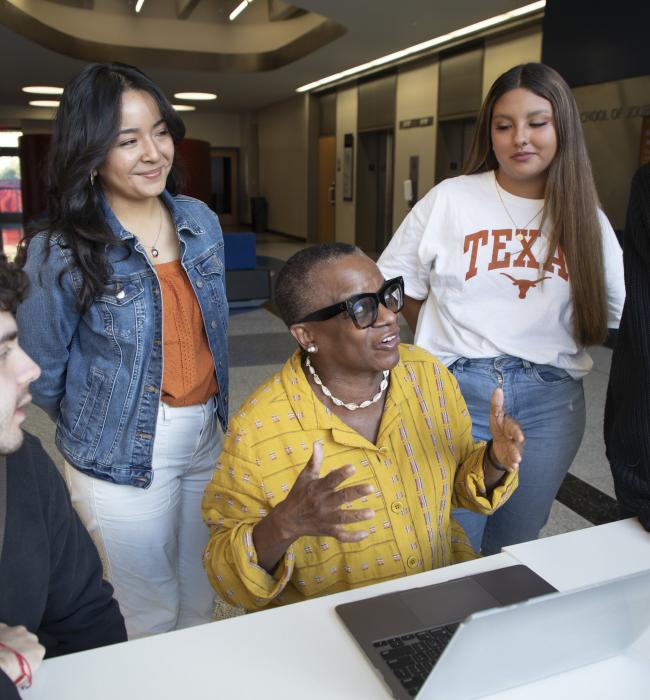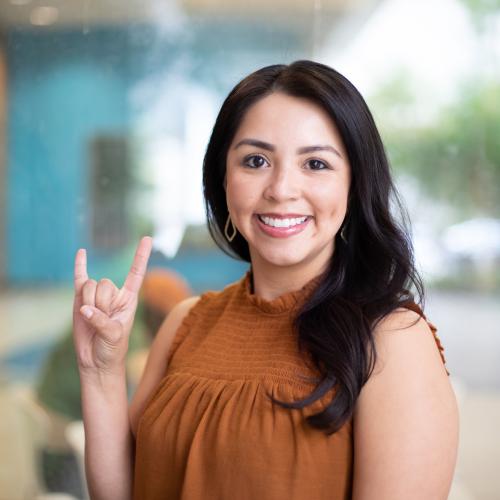About Journalism and Media
Welcome to one of the most forward-leaning schools of journalism and media in the country. Our faculty educate students to think critically and creatively about the pressing issues facing the industries we serve—from changing business models to emerging technologies. We train them to practice journalism and storytelling that is grounded in a strong ethical foundation and excellent writing and reporting skills. We prepare them for the future with classes in multimedia journalism, podcasting, coding for journalists, video storytelling, AI and journalism, and much else. We do all of this while helping them take advantage of our location in Austin, Texas, one of the country’s hotbeds of journalism and media innovation. When they leave us, our students become reporters and editors, producers and directors, social media managers and multimedia storytellers with companies across the journalism and media landscape—from the New York Times to Facebook, Bloomberg News to Disney. We couldn’t be prouder of them, or the work we do to help them achieve their dreams.

David Ryfe, Professor and Director
Our Vision
Our vision is to be a global center of innovation in the research and practice of ethical
journalism and media in the service of democracy.

World Class Production Facilities
State-of-the-art production studios, including a news photo & TV production studio, numerous audio recording and editing suites for generating sound FX, recording voiceovers, and producing podcasts, and a vast array of high-quality production equipment available for students to checkout.

Texas is Home to Two Top 10 Media Markets
While studying at Moody College you’ll be learning and working beside professionals that have experience in the largest media markets in the country as well as local and rural markets. Austin is a top 40 media market and Texas as the #5 and #7 largest media markets in the country.

Experienced Faculty
Our faculty have award winning books as well as contributed to esteemed publications like New York Times, Los Angeles Times, Chicago Tribune, Houston Chronicle, Texas Monthly, Newsweek, Washington Post, TIME, ABC, NBC, BS, Fox, and more.

Luisa Cantu
Lizzie Pena

Yazmin Strauss
More About the School of Journalism and Media
Mission Statement
Our mission is to lead the field of journalism and media education as a hub of innovation and excellence in research and practice that responds nimbly to the changing face of public knowledge that is important to society. We are dedicated to inspiring the next generation of journalism and media professionals with an entrepreneurial spirit, and to equip them with the evolving array of skills and insights necessary to transform and re-create media to benefit a healthy democracy. We infuse our research, teaching, and practice with the core values and ethics of journalism, understanding their importance to our broader culture and political processes. We believe diversity in journalism and related media professions is essential. For this reason, we are committed to regularly updating our knowledge, skills, and curriculum so that our students will be prepared as journalists to report on diversity, accurately, fairly, and without stereotypes. We believe the best media professionals are good citizens competent to critically assess the evolving media ecology in which we live and capable of living and working within a diverse, inclusive, equitable, and global society. We devote ourselves to strengthening the professions and improving the communities we serve. In these pursuits, we are eager to partner with others on and off campus, in Texas and around the world to society’s benefit.
Updated 2022.
The University of Texas at Austin’s School of Journalism started in 1914, in a building that housed heavy printing machinery and was heated by coal-burning stoves. It has grown into the largest and most important program of its kind in Texas, a vital part of one of the nation’s best public universities and now home to courses ranging from mobile app development to international reporting in a digital age.
The School’s noteworthy alumni include Claudia Alta Taylor, who married a young politician and became known as Lady Bird Johnson; Walter Cronkite, who dropped out after two years to take a newspaper job; and Liz Carpenter and Bill Moyers, whose distinguished careers spanned journalism and public service. Lady Bird, Carpenter and Moyers were all aboard Air Force One when Lyndon Johnson took the oath of office after the assassination of President John F. Kennedy, while Cronkite broadcast the news to the world.
Today, our graduates work in traditional and startup media organizations around the world, including The New York Times, The Washington Post, Reuters, ProPublica, The Texas Tribune, ESPN, NBC News and CBS News. Graduates and faculty, past and present, have won more than 25 Pulitzer Prizes for journalism.
The School has been continuously accredited since 1948. Throughout that time, the faculty – representing a strong blend of scholarly and professional achievement -- has been known for its hands-on approach in teaching, mentoring and editing to provide students with both the sensibilities and the skills to be complete journalists and valuable contributors to an open, democratic society.
“I think all of us developed really close relationships with the professors,” said alumna Karen Tumulty, a national political correspondent for The Washington Post. “They wanted to shape us, not just so that you came out of the School knowing how to write a headline that fits in a certain space, but so you came out of the School with the right kind of values for journalism.”
In 1965, the School joined with two other departments to become the College of Communication, rechristened as the Moody College of Communication in 2013 after a $50 million gift from the Moody Foundation of Galveston. The college now includes the School of Journalism and Media, the Stan Richards School of Advertising and Public Relations, and three departments: Communication Studies, Speech Language and Hearing Sciences, and Radio-Television-Film.
In 2012, the School of Journalism and Media moved into the Belo Center for New Media (now G.B. Dealey Center for New Media) and introduced a converged, digitally based undergraduate curriculum with new courses at the lower and upper levels. In 2014, the school celebrated its centennial. The following year, a $1.5 million gift from the Belo Foundation established an endowment to advance journalism innovation at UT Austin.
Student work inside the Dealey Center is reinforced by strong relationships beyond its doors. The School benefits from a committed, well-placed network of alumni and from partnerships with news organizations throughout Texas. This enables our students to obtain quality professional internships and jobs in the major media markets of Austin, Dallas/Fort Worth, Houston and San Antonio, as well as in national venues.
William H. Mayes was named as organizer and director of the School, and served from 1914 to 1927.
Paul J. Thompson became a faculty member of the School of Journalism in 1919, beginning a 45-year career of journalism teaching and administration. He served as chairman of the department from 1927 to 1958.
DeWitt C. Reddick, one of the founders of the College of Communication, joined the journalism faculty in 1927 and served as director of the school from 1959 to 1965 when he became the first dean of the College of Communication. He served as dean until 1969. Below is the list of past directors:
- Norris Davis
- Griff Singer
- Dwight Teeter
- Mike Quinn
- Max McCombs
- Wayne Danielson
- Rusty Todd
- Steve Reese (1996-2002)
- Lorraine Branham (2002-2007)
- Tracy Dahlby (2008-2010)
- Glenn Frankel (2010-2014)
- R.B. Brenner (2014-2018)
- Kathleen McElroy (2018-2022)
- David Ryfe (2022-present)
Contact Us
Email: journalism@austin.utexas.edu
Phone: 512-471-1845





